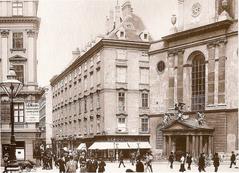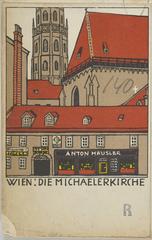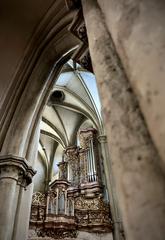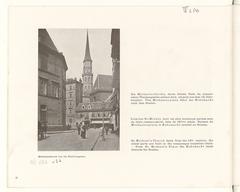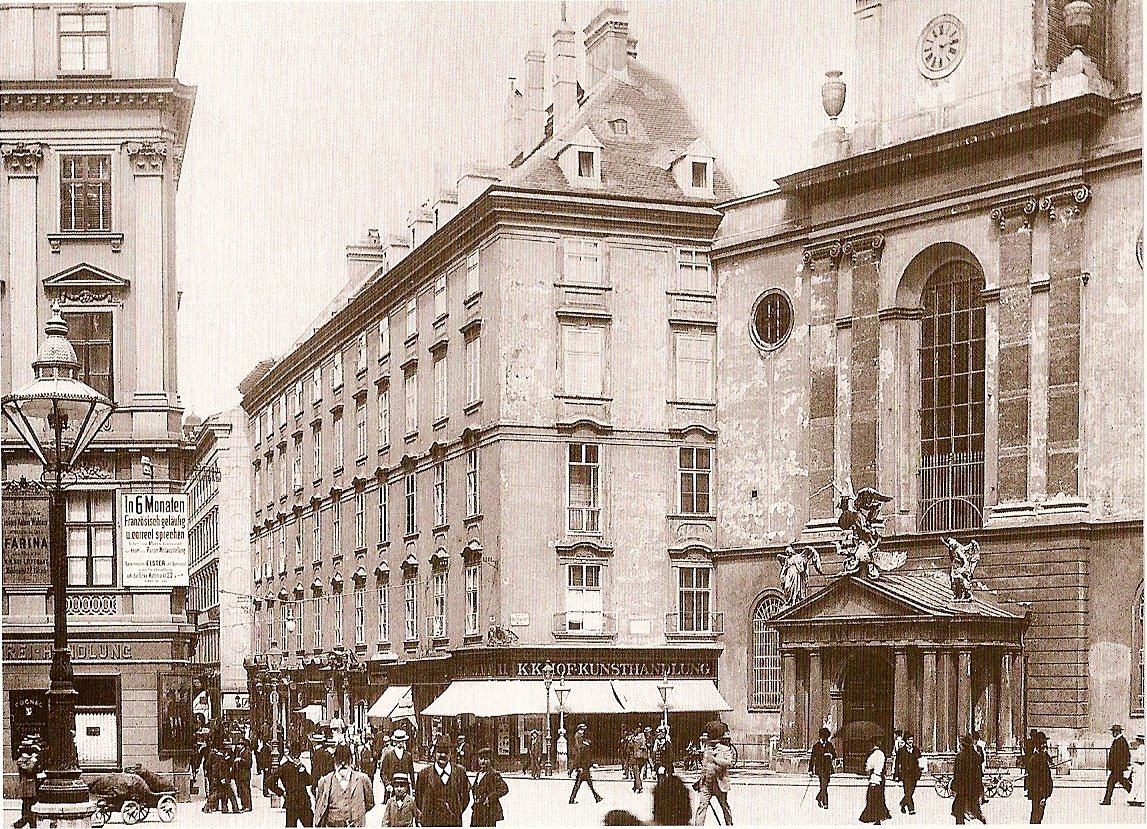
St. Michael’s Church Vienna: Visiting Hours, Tickets, and Comprehensive Travel Guide
Date: 14/06/2025
Introduction
St. Michael’s Church (Michaelerkirche), located at the heart of Vienna’s historic center on Michaelerplatz, stands as a remarkable testament to over 800 years of architectural evolution, spiritual tradition, and cultural significance. As one of the city’s oldest ecclesiastical buildings, it weaves together Romanesque, Gothic, and Baroque elements, offering visitors a unique journey through Vienna’s rich heritage. Once the parish church of the Habsburg imperial court, St. Michael’s has long anchored Michaelerplatz, directly facing the Hofburg Palace. The church is renowned for its artistic treasures, including the Sieber Organ—Vienna’s largest Baroque pipe organ—and the atmospheric Michaelergruft crypt, which preserves over 4,000 naturally mummified corpses, thanks to the crypt’s unique microclimate.
This guide provides everything you need to know for a memorable visit: historical context, architectural highlights, visiting hours, ticketing, practical tips, and nearby attractions. Whether you’re interested in medieval architecture, Baroque artistry, or Vienna’s storied musical tradition—including the celebrated “Orgel um 8” concert series—St. Michael’s Church offers a rich experience for every traveler. For up-to-date details and further resources, consult the official Michaelerkirche website, as well as trusted travel platforms (allaboutvienna.com; vienna.net; infonewslive.com).
Table of Contents
- Introduction
- Historical Evolution: Romanesque to Baroque
- Architectural & Artistic Features
- The Michaelergruft Crypt
- Musical Heritage and Events
- Practical Visitor Information
- Top Photography Spots
- FAQs
- Nearby Attractions
- Final Tips and Conclusion
- References & Further Reading
Historical Evolution: Romanesque to Baroque
Romanesque Origins
St. Michael’s Church was constructed circa 1220–1240, making it one of Vienna’s oldest surviving churches. Its original Romanesque character is still visible in the fortress-like lower west façade, with its rounded arch portal and thick masonry, reflecting the solidity and simplicity typical of the era (allaboutvienna.com; Wikipedia).
Gothic Expansion
Between the 14th and 15th centuries, the church underwent significant Gothic expansion, most notably the addition of a tall, slender tower completed in 1510. The pointed arches, ribbed vaulting, and vertical emphasis of the nave echo the grandeur of the Gothic style (vienna.net).
Baroque Transformation
The Baroque era brought lavish enhancements, including the high altar, side chapels, and breathtaking ceiling frescoes. The most significant addition was the Sieber Organ, built in 1714, which remains Vienna’s largest Baroque pipe organ. The main entrance was framed with a Baroque portico, featuring dynamic sculptural work and Corinthian columns (Vienna Unwrapped).
Architectural & Artistic Features
Exterior
- Romanesque Base: The west façade’s rounded arches and thick masonry exhibit the church’s Romanesque roots.
- Gothic Tower: The 52-meter-high octagonal spire, added in the Gothic period, is topped by a copper roof and dominates the Vienna skyline.
- Baroque Sculptural Group: Above the entrance, Lorenzo Mattielli’s 1725 sculpture of St. Michael defeating Lucifer captures Baroque drama.
Interior
- Nave and Vaults: The interior combines pointed Gothic arches and ribbed vaults with Romanesque columns, some retaining their original foliate capitals (Sacred Destinations).
- High Altar: Designed by Jean-Baptiste d’Avrange in 1782, the altar features Michael Rottmayr’s monumental painting “The Fall of the Angels,” surrounded by gilded angels.
- Side Chapels: Notable chapels include the Baroque Chapel of St. John Nepomuk and the Gothic Chapel of the Holy Cross with its expressive crucifix.
- Frescoes & Stained Glass: 18th-century frescoes illustrate scenes from St. Michael’s life; 19th-century stained glass windows depict biblical figures in vibrant color.
Artistic Treasures
- Tomb of Pietro Metastasio: The Italian poet and librettist is interred in the crypt.
- Bronze Reliefs: Inside, bronze plaques commemorate major musical events, including the first performance of Mozart’s Requiem at his funeral in 1791 (Wien Info).
The Michaelergruft Crypt
Beneath the church lies the Michaelergruft, a crypt that preserves over 4,000 corpses, many naturally mummified by the unique microclimate. Coffins are elaborately decorated in the Baroque style, and some retain original burial garments and even floral tributes. Guided tours reveal the burial customs of Vienna’s elite from the 16th to 18th centuries (vienna.net; Vienna Unwrapped).
Musical Heritage and Events
The Sieber Organ
Installed in 1714, the Sieber Organ is a highlight of Vienna’s sacred music scene, with 40 stops and over 2,500 pipes. It is celebrated for its rich, resonant sound and historical significance, having been played by a young Joseph Haydn.
“Orgel um 8” Concert Series
From June to September, the “Orgel um 8” series takes place every Saturday at 8 PM, showcasing the Sieber Organ in performances spanning Baroque to contemporary repertoire. Following the concerts, visitors can access the organ gallery with bilingual commentary.
Special Musical Events
St. Michael’s also hosts festivals, such as the upcoming celebration of Marianna Martines in June 2025, and master’s recitals in collaboration with Vienna’s University of Music and Performing Arts. Select concerts are recorded and available for streaming through the church’s digital archive (Michaelerkirche Official).
Practical Visitor Information
Opening Hours
- Church: Daily, 7:00 am – 10:00 pm (8:00 am – 10:00 pm on Sundays and holidays)
- Parish Office: Monday, Tuesday, Thursday, Friday: 9:00 am – 12:00 pm
Admission & Tickets
- Main Church: Free entry; donations are appreciated
- Crypt Tours: Guided only; tickets required (approx. €5, with discounts for students and seniors)
Guided Tours
Tours provide deep insights into the church’s history, art, and crypt. Booking in advance is recommended, particularly during peak tourist seasons.
Accessibility
- Main Nave: Wheelchair accessible
- Crypt: Access involves stairs and is not suitable for visitors with mobility challenges
Dress Code & Behavior
- Wear modest attire (no shorts or sleeveless tops)
- Maintain silence, especially during religious services
Photography
- Allowed without flash
- Refrain from photographing during services to respect worshippers
Top Photography Spots
- The Romanesque portals and Gothic vaulting
- Baroque high altar and ceiling frescoes
- The sculptural group above the main entrance
- Michaelerplatz archaeological site outside the church
- Interior bronze plaques and crypt art
FAQs
Q: What are the visiting hours for St. Michael’s Church?
A: Daily from 7:00 am to 10:00 pm (8:00 am on Sundays/holidays).
Q: Is there an entrance fee?
A: Entry to the church is free; crypt tours require a ticket.
Q: Are guided tours available?
A: Yes, both for the church and the crypt. Check the official website for schedules.
Q: Is the church wheelchair accessible?
A: The main nave is accessible, but the crypt is not.
Q: Can I take photos inside?
A: Yes, without flash and not during services.
Nearby Attractions
- Hofburg Palace: Directly opposite the church
- Roman Vindobona Remains: Archaeological excavations on Michaelerplatz (Explorial)
- Spanish Riding School & Sisi Museum: Adjacent to Michaelerplatz
- Graben and Kohlmarkt: Famous pedestrian shopping and historic streets
- St. Stephen’s Cathedral: A short walk away
Final Tips and Conclusion
St. Michael’s Church stands as a living chronicle of Vienna’s layered history, from its Romanesque foundations to Gothic and Baroque grandeur. Its prime location, architectural marvels, unique crypt, and ongoing musical heritage make it a must-visit for history, art, and music lovers alike. For a comprehensive experience, combine your visit with nearby attractions and check the official website for the latest schedules, ticketing, and special event information.
For deeper exploration, consider using the Audiala app for audio guides, interactive maps, and up-to-date visitor tips. Respect the church’s sacred atmosphere and enjoy a journey through centuries of Viennese culture.
References & Further Reading
- St. Michael’s Church Vienna: Visiting Hours, Tickets, History & Architectural Highlights (allaboutvienna.com)
- St. Michael’s Church Vienna: Visiting Hours, Tickets, History & Architectural Highlights (vienna.net)
- Austria’s Top 12 Stunning Churches to Visit in Vienna (infonewslive.com)
- St. Michael’s Church, Vienna (Wikipedia)
- St. Michael’s Church Vienna Architectural and Artistic Overview (Vienna Unwrapped)
- St. Michael’s Church Vienna Musical Heritage and Visiting Info (Michaelerkirche Official)
- St. Michael’s Church Visiting Hours, Tickets, and Tips (Visiting Vienna)
- Michaelerplatz and Roman Excavations (Explorial)
- The Vienna Blog: The 12 Most Beautiful Churches in Vienna to Visit (The Vienna Blog)
